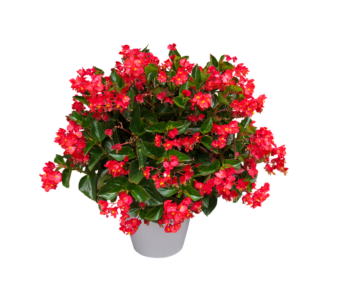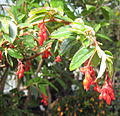In this article, we will be discussing how to grow begonia as a houseplant. Anybody who is familiar with outdoor plants, know about begonias as beautiful bedding plants but many varieties can be grown indoors.
In fact, begonias are a popular houseplant, where some are grown for their blooms, whilst others are grown for their elegant, colourful leaves. In this article, we will talk about how to look after these plants and the varieties to grow in the home.
HOW TO GROW BEGONIAS AS A HOUSEPLANT

Indoor begonias tend to fall into 4 types of tuberous, fibrous, cane-stemmed and rhizomatous. If you are looking for easier and more long-lived houseplants then fibrous and rhizomatous are the ones to go for. Tuberous, on the other hand, tend to do better outdoors, but they can be grown in a home environment but they tend not to do well. In fact, if you do not grow in exact conditions of high humidity and better light, it will simply fail.
Fibrous root begonias are tender evergreen with erect, shrubby stems. Most are grown for their colourful leaves that are often marked silver and come in elaborate shapes. B. scharfii (Elephant Ear Begonia) and B. semperflorens-cultorum (Wax Begonia) fall into this group.
Cane stemmed begonias tend to be woody, fibrous evergreen perennials that are also tender, The stems are bamboo-like, erect, smooth and have swollen node. The plants that fall in this group include B. stipulacea and B. maculata (Polka Dott Begonia) that are grown for their beautiful leaves and long-lasting flowers.
One of the main groups for indoor plants is rhizomatous begonias and are often grown for their bright colourful leaves, B. masoniana (Iron Cross Begonia) and B. rex hybrids (Rex Begonia) are found in this group. It is a tender evergreen perennial that has a creeping rootstock.
Tuberous begonias (Begonia x tuberhybrida) are largely winter-flowering plants whose hybrids are grown as short term pot plants. After flowering, they are usually discarded. They tend to be available all year round due to improved cultivation methods.
GROWING CONDITIONS FOR BEGONIAS
LIGHT
All begonia types need bright, indirect light to grow in. Provide this and they will grow away quite happily. Give it shade and the flowering types will hate it. Begonias grown for the leaves will fare a bit better but will still struggle, Grow it in bright sunlight and the plant leaves will be bleached and will not look too attractive. So avoid bright, direct sunlight and avoid too much shade.
WATERING
Begonias like to have water in the right quantities-not too much, not too little. Often too much is the biggest problem, where the roots will start to rot and fungal diseases can take hold. Avoid waterlogging at all costs, allowing the compost to dry out a little between waterings. It is best to water when 5cm below the top of the surface feels dry when you stick your finger into the compost.
HUMIDITY
Begonias do like the air that surrounds it to be humid, it will struggle in a very dry atmosphere near radiators. Do not mist the leaves or place in a wet atmosphere as the plant leaves hate constant moisture. You need to locate it in an area of high humidity.
TEMPERATURES
They are not at all fussy about the temperatures they are exposed to, as long as it is above 10 degree Celsius and below 25 degree Celsius. Avoid freezing temperature that will kill the plant. As the plants grow, it will need to be repotted every couple of years or so to refresh the growing media and to allow the root to expand in the new growing media.
Rhizomatous begonias are an exception, they have shallow roots so it should be planted in shallow pots to avoid watering problems.
FERTILIZER
Begonias are hungry plants and will need feeding often when in active growth-once every month is ideal. For leafy begonias use a high nitrogen-based fertilizer, whilst for flowering types use a fertilizer with high potash.
FLOWERS
All begonias will flower even those grown for their leaves. The blooms can appear at any time and can be long-lasting or for a short time. As some plant produces lots of flowers in succession that it can give a display lasting for weeks to several months.
Tuberous begonias will go dormant when the light gets shorter in autumn and winter. As the leaves turn yellow and drop off, it is best to cut off any remaining stems to just above the soil level. At this stage, do not water at all and once the soil has dried out completely, move it to a frost-free location for a few months until spring for some rest.
VARIETIES OF BEGONIA TO GROW
BEGONIA BOWERI (Eyelash Begonia)

This is a small begonia, growing up to 22cm in height with leaves that have edges that are fringed with lash-like hairs. The leaves have chocolate-brown marking and also produced pretty pink-white flowers.
BEGONIA CATHAYANA (Chinese Begonia)

Looks like a tall-growing Rex Begonia with similar leaf colouring and markings, but the leaves texture is velvety and the stems are reddish. This striking plant can grow to 60cm in height. The stems of this plant can become brittle, so move about with great care or they may snap off.
BEGONIA COCCINEA (Angel Wing Begonia)

This plant has spear-shaped leaves with red margins. The panicles of bright red or pink flowers that appear in spring to autumn make this a delightful plant. ‘President Carnot’ has silvery speckling on the leaves and has paler flowers. Will survive quite a low temperature if kept on the dry side.
BEGONIA x CORALLINA (Spotted Angel Wing)

The most popular cultivar to grow is ‘Lucerna’ that has bold, ear-shaped, irregular-edged leaves that are olive green and silver spotted, purple-red below. It produces masses of pinkish flowers on stout cane-like stems, where it can reach 90cm high. Can survive some neglect.
BEGONIA FUCHSIOIDES (Fuchsia Begonia)

This is a compact, shrubby plant with glossy oblong leaves and in autumn flower if red/pink appear in clusters. Can reach a height of 1.2m and is fairly easy to grow. Do not firm the compost too much when potting on, as the plant prefers loose growing media.
BEGONIA HAAGEANA (Elephant’s Begonia)
This 1.2m tall plant has dark green leaves with whitish hairs and red veins that are reddish below. In summer pretty pinkish-white flowers appear. Can take more light than most begonias, where it needs to be cut back to maintain compactness.
BEGONIA MANICATA (Pink Showers)

This 45cm tall plant has arrow-shaped, pale green and smooth leaves with thin reddish edges. As the plant grows older the leaves become rounded and more heart-shaped. In winter, a profusion of pinkish flowers on tall spikes appear. An easy plant to grow.
BEGONIA MASONIANA (Iron Cross Begonia)

This is similar to the well-known Rex Begonia but is smaller and more compact and bristly. The leaves are striking in that it has a bold chocolate brown central leaf marking that look like an Iron cross. An easy plant to look after.
BEGONIA METALLICA (Metal Begonia)

This is a begonia that has branching habit, whose leaves have a metallic lustre that is veined and crimson below. In autumn, white to pink flowers appear where the plant can reach 1m.
BEGONIA REX (Rex Begonia)

This begonia has crinkled, irregular–edged, spear-shaped leaves. The leaves are stunning and often have beautiful colours and marking with silvery variegation. It grows up to 30cm in height where it does its best in slight shade.
BEGONIA SEMPERFLORENS (Bedding Begonia)

This popular summer bedding plant is often used outside but it can be used indoors to produce winter blooms on a sunny windowsill. This is a begonia that is grown for its red yellow, orange or white blooms, where it can grow up to 23cm in height. Can be grown from seeds.
BEGONIA x TUBERHYBRIDA (Tuberous Begonia)

This is another Begonia-grown for its flowers that can be either single, double or tassel-like on some pendular forms where it can grow up to 60cm high.
Can be grown indoor via shop-bought tubers.
CONCLUSIONS
In this article, how to grow begonia as houseplants have been discussed from the type to grow, its preferred growing conditions and how to get the best from them. As you can see there are a lot of begonias on the market that can be safely grown indoor, be it for the leaves or the flower, or both.
These are some of the most beautiful houseplants that you can grow, especially if you get the right variety and the right growing conditions.
If you have any begonia related comments or questions that you wish to raise, please do so in the comment box below.
Grow a houseplant begonia today.
